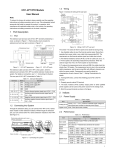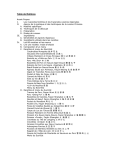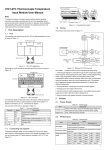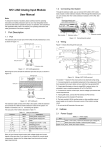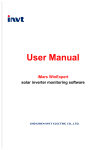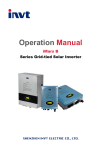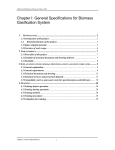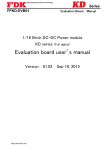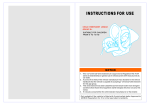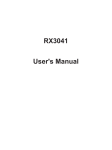Download IVC1 Series DC PLC Quick Start User Manual
Transcript
IVC1 Series DC PLC Quick Start User Manual 1 Introduction 1.1 Model Designation The model designation is shown in the following figure. Thank you for using INVT programmable logic controller (PLC). Before using the product, please carefully read this booklet so as to better understand it, fully use it, and ensure safety. 16 14 M D R IVC 1 This quick start manual is to offer you a quick guide to the design, installation, connection and maintenance of IVC1 series DC-powered PLC, or DC PLC, convenient for on-site reference. This booklet briefly introduces the hardware specs, features, and usage of IVC1 series DC PLC, plus the optional parts and FAQ for your reference. For detailed product information, please refer to our IVC1 Series PLC User Manual, Auto Station Programming Software User Manual, and IVC Series Micro-PLC Programming Manual. For ordering the above user manuals, contact your INVT distributor or sales office. You can also download the PLC technical documents or feed back PLC-related problems by visiting our web site at www.invt.com.cn. 1.2 Outline The outline of the basic module is shown in the following figure by taking the example of IVC1-1614MDR. Power supply terminals Mode selection switch Input terminals Input status indicators PORT 0 Extension port System status indicators Output status indicators To Customers: Thank you for choosing our products. To improve the product and provide better service for you, could you please fill in the form after the product has been operated for 1 month, and mail or fax it to our Customer Service Center. Thank you very much! Invt Control Technology Co., Ltd. Product Quality Feedback Form Customer name Tele Address Zip code Model Date of use Machine SN Appearance or structure PORT 1 Output terminals Variable analog potentiometer PORT 0 and PORT 1 are communication terminals. PORT 0 uses RS232 mode with Mini DIN8 socket. PORT 1 uses RS485 or RS232 mode. The busbar socket is for connecting the extension module. The mode selection switch has three positions: ON, TM and OFF. 1.3 Terminal Introduction The layouts of terminals of different I/O points are shown below: 1) 16-point Input terminal: S /S X0 X2 X1 X4 X3 X6 X 10 X5 X7 X 11 Performance Output terminal: Package Material Quality problem during usage Suggestion about improvement Address: Gaofa Industrial Park, Longjing, Nanshan District, 518055, Shenzhen, PRC. Tel: +86 755 Y0 COM 0 Y1 COM 1 Y2 Y3 Y5 Y4 COM 2 2) 24-point Input terminal: S /S X0 X2 X1 X4 X3 X6 X5 X 10 X7 X 12 X 11 X 13 X 14 X 15 Output terminal: Y0 Y1 Y2 Y4 Y6 Y 10 COM 0 COM 1 COM 2 Y3 Y5 Y7 Y 11 3) 30-point Input terminal: S /S X0 X2 X1 X4 X3 X6 X5 X 10 X7 X 12 X 11 X 14 X 16 X 13 X 15 X 17 Output terminal: Y0 Y1 Y2 Y4 Y6 COM 0 COM 1 COM 2 Y3 Y5 Y7 Y10 Y 12 Y 14 COM 3 Y 11 Y 13 Y 15 4) 40-point 4 Input terminal: S /S 24V DC X0 X2 X1 X4 X3 X6 X10 X5 X7 X12 X 11 Use terminal block to connect common terminals X 13 X 20 X 22 X 24 X 26 X 14 X 16 X 15 X 17 X 21 X23 X25 X27 PG +24V VGND 24V+ Output terminal: 24V- Y0 Y1 Y2 Y4 COM 0 COM 1 COM 2 Y3 Y5 Sensor 24V- 24V+ S/S S/S X0 Y 16 Y 10 Y 12 Y 14 COM 3 Y 11 Y 13 Y 15 Y 17 Y6 Y7 X2 X3 X4 X16 X17 X0 X1 X7 IVC1-0808ENR EC10-0808ERN EC10-1614BRD IVC1-1614MDR +24V Switching power supply X1 +5V GND 5) 60-piont Y0 COM0 Input terminal: S /S X0 X2 X1 X4 X3 X6 X 10 X5 X7 X 12 X 11 X 14 X 16 X 13 X 15 X 17 3.2 Y1 COM1 Y2 Y3 Y4 Y5 Y6 Y7 COM2 Y10 Y11 COM3 Y0 Y1 Y2 COM Output Characteristic And Specification The following table shows the relay output and transistor output. X 20 X 22 X 21 X 24 X 26 X 30 X32 X 34 X 36 X 40 X 42 X 23 X 25 X27 X 31 X 33 X 35 X 37 X 41 X 43 Output terminal: Y0 Y1 Y2 COM 0 COM 1 COM 2 Y 12 Y4 Y3 Y5 Y 14 Y 13 Y6 Y7 COM 3 Y 11 Y 26 Y 20 Y 22 Y 24 COM 4 Y21 Y23 Y 25 Y27 Y 16 Y 15 Y10 Y 17 2 Power Supply The specification of PLC built-in power source is listed in the following table. Item Unit Min. Rated Max. Power supply voltage Vac 19 24 30 Input current A 0.85 / Output 5V/GND mA current 24V/GND mA / / 900 / / 300 / Note For normal startup and operation. Enhanced or double insulation is required 24Vdc input The total power of two outputs ≤ 10.4W Relay output Divided into multiple groups, each with a common terminal COMn, suitable for control circuits with different potentials. All common terminals are isolated from each other 220Vac; 24Vdc, no Voltage 24Vdc, correct polarity required polarity requirement Current Accord with output electric specs (see following Table ) High driving voltage, Small driving current, high frequency, Difference large current long lifespan Loads with high frequency and long Loads with low action life, such as control servoamplifier frequency such as Application and electromagnet that action intermediate relay, contactor coil, and LEDs frequently Common terminal The following table shows the electric specs of output terminals. Item Switched voltage Circuit isolation Operation indication Relay output terminal Below 250Vac, 30Vdc By Relay Relay output contacts closed, LED on Electric parameters Input mode Input voltage Input impedance Input ON Input OFF High-speed input General input terminal terminals X0~X7 Source mode or sink mode, set through s/s terminal 24Vdc 3.3kΩ 4.3kΩ External circuit resistance < 400Ω External circuit resistance > 24kΩ X0~X17 have digital filtering function. Filtering time: 0, Digital filter Filtering 8, 16, 32 or 64ms (selected through user programme) function Hardware Input terminals other than X0 ~ X17 are of hardware filter filtering. Filtering time: about 10ms X0~X7: high-speed counting, interrupt, and pulse catching High-speed function X0 and X1: up to 50kHz counting frequency X2~X5: up to 10kHz counting frequency The sum of input frequency should be less than 60kHz Common terminal Only one common terminal: COM The input terminal acting as a counter has a limit over the maximum frequency. Any frequency higher than that may result in incorrect counting or abnormal system operation. Make sure that the input terminal arrangement is reasonable and the external sensors used are proper. Max. output current Item Less than 0.1mA/30Vdc 20ms Max 20ms Max / Each channel: 100kHz Resistive load 2A/1 point; 8A/4 points, using a COM 8A/8 points, using a COM Inductive load 220Vac, 80VA Illumination load 220Vac, 100W Response OFF→ON time ON→OFF Y0, Y1 max. output frequency Output common terminal Fuse protection Transistor output terminal 5~24Vdc PhotoCoupler LED is on when optical coupler is driven 5mA (5~24Vdc) Y0, Y1: 0.3A/1 point; Others: 0.3A/1 point, 0.8A/4 point, 1.2A/6 point, 1.6A/8 point. Above 8 points, total current increases 0.1A at each point increase Y0, Y1: 7.2W/24Vdc Others: 12W/24Vdc Y0, Y1: 0.9W/24Vdc Others: 1.5W/24Vdc Y0, Y1: 10us Others: 0.5ms Input Characteristic And Specification The input characteristic and specs are shown as follows: Transistor output When output state is ON, the circuit is closed; OFF, open Leakage current of open / circuit Minimum load 2mA/5Vdc 3 Digital Inputs & Outputs 3.1 Item Output mode Y0-COM0; Y1-COM1. After Y2, every 8 terminals use one isolated common terminal None Output connection example The following diagram shows an example of IVC1-1614MDR in connection with an IVC1-0808ENR. Different output groups can be connected to different signal circuits with different voltages. Some (like Y0-COM0) are connected to the 24Vdc circuit, some (like Y1-COM1) are connected to the 5Vdc low voltage signal circuit, others (like Y2~Y7) are connected to the 220Vac voltage signal circuit. Input connection example The following diagram shows an example of IVC1-1614MDR in connection with an IVC1-0808ENR, which realizes simple positioning control. The positioning signals from the PG are input through high speed counting terminals X0 and X1, the limit switch signals that require high-speed response can be input through high-speed terminals X2 ~ X7. Other user signals can be input through any other input terminals. 5 Cable specification When wiring a PLC, use multi-strand copper wire and ready-made insulated terminals to ensure the quality. The recommended model and the cross-sectional area of the cable are shown in the following table. Wire Power cable (24V+, 24V-) Earth cable ( ) Input signal cable (X) Output signal cable (Y) Cross-sectional Recommended Cable lug and heat area model shrinkable tube H1.5/14 round insulated 1.0~2.0mm2 AWG12, 18 lug, or tinned cable lug H2.0/14 round insulated 2.0mm2 AWG12 lug, or tinned cable end UT1-3 or OT1-3 AWG18, 20 0.8~1.0mm2 solderless lug Φ3 or Φ4 heat shrinkable tube 0.8~1.0mm2 Warning 1. Never connect the transistor output to an AC circuit (like 220Vac). The design of the output circuit must abide by the requirements of electric parameters, and no over-voltage or over-current is allowed. 2. Use the relay contacts only when necessary, because the life span of relay contacts depends largely on its action times. 3. The relay contacts can support loads smaller than 2A. To support larger loads, use external contacts or mid-relay. 4. Note that the relay contact may fail to close when the current is smaller than 5mA. AWG18, 20 Fix the prepared cable head onto the PLC terminals with screws. Fastening torque: 0.5 ~ 0.8Nm. The recommended cable processing method is shown in the following figure. ≤ 5.0 UT solderless lug ≤ 5.0 Heat shrinkable tube Cable 18 Cable SN label OT solderless lug Heat shrinkable tube 47 H type round insulated lug 682 Tinned cable end Cable PG 6 Power-on Operation And Maintenance Startup 1. Check the cable connection carefully. Make sure that the PLC is clear of alien objects and the heat dissipation channel is clear. 2. Power on the PLC, the PLC POWER indicator should be on. 3. Start the Auto Station software on the host and download the compiled user program to the PLC. 4. After checking the download program, switch the mode selection switch to the ON position, the RUN indicator should be on. If the ERR indicator is on, the user program or the system is faulty. Loop up in the EC series Small PLC Programming Manual and remove the fault. 5. Power on the PLC external system to start system debugging. Routine maintenance Notice 1. The warranty range is confined to the PLC only. 2. Warranty period is 18 months, within which period INVT conducts free maintenance and repairing to the PLC that has any fault or damage under the normal operation conditions. 3. The start time of warranty period is the delivery date of the product, of which the product SN is the sole basis of judgment. PLC without a product SN shall be regarded as out of warranty. 4. Even within 18 months, maintenance will also be charged in the following situations: Damages incurred to the PLC due to mis-operations, which are not in compliance with the User Manual; Damages incurred to the PLC due to fire, flood, abnormal voltage, etc; Damages incurred to the PLC due to the improper use of PLC functions. 5. The service fee will be charged according to the actual costs. If there is any contract, the contract prevails. 6. Please keep this paper and show this paper to the maintenance unit when the product needs to be repaired. Do the following: 1. Ensure the PLC a clean environment. Protect it from aliens and dust. 2. Keep the ventilation and heat dissipation of PLC in good condition. 3. Ensure that the cable connections are reliable and in good condition. 7 Troubleshooting 7. If you have any question, please contact the distributor or our company directly. INVT Control Technology Co., Ltd. Address: Gaofa Industrial Park, Longjing, Nanshan District, 518055, Shenzhen, PRC Homepage: www.invt-control.com.cn If the PLC is faulty, take the following measures: 1. Check the connection of the power supply cable, and the related switches & protective devices. 2. Ensure the user terminal connections are reliable. Version: V1.0 Revision date: Sep 6, 2011 Copyright © 2011 by Invt Control Technology Co., Ltd. All rights reserved. The contents in this document are subject to change without notice. 3. Ensure that the mode selection switch is in the right position. If all the conditions are normal but the PLC still does not work, you can analyze the problem according to the PLC operation state and the I/O state LEDs by referring to IVC1 Series PLC User Manual. 7 24V+ 24V- 24V- 24V+ S/S X0 +24V Switching power supply Y0 COM0 Y1 COM1 Y2 X1 X2 X3 X4 X16 X17 IVC1-1614MDR EC10-1614BRD +5V GND Y3 Y4 Y5 Y6 Y7 COM2 Y10 Y11 COM3 AC-L 5.1 Installation Dimensions Model IVC1-1006MDT IVC1-1006MDR IVC1-1410MDT IVC1-1410MDR IVC1-1614MDT IVC1-1614MDR IVC1-2416MDT IVC1-2416MDR IVC1-3624MDT IVC1-3624MDR 5.2 90mm 135mm Width Length Height Weight 500g 71.2mm 600g 150mm 182mm 224.5mm 90mm 90mm 90mm 71.2mm 71.2mm 71.2mm 650g 750g 950g Installation Method DIN rail mounting A B A B A B A B A B A B A B A B +24V AC-N +5V Various low voltage control circuits 220Vac control load circuit Generally you can mount the PLC onto a 35mm-wide rail (DIN), as shown in the following figure. Use terminal block to connect common terminals Rail stop Rail stop 4 Communication Port IVC1 series DC PLC basic module has two serial asynchronous communication ports: PORT 0 and PORT 1. The supported baud rates include: 115200bps 9600bps 57600bps 4800bps 38400bps 2400bps 19200bps 1200bps The mode selection switch determines the communication protocol of PORT 0. Pull out the DIN rail clip 35mm DIN rail 2 8 5 7 4 Pin No. 3 1 6 3 RS485 terminal Status Press back the DIN rail clip Screw fixing Fixing the PLC with screws can stand greater shock than DIN rail mounting. Use M3 screws through the mounting holes on PLC enclosure to fix the PLC onto the backboard of the electric cabinet, as shown in the following figure. PORT 0 A Mode selection switch 4 A amplified Fix with M3 bolt Name GND Description Ground Serial data receiving pin (from RS232 to PLC) RXD Serial data 5 TXD transmitting pin (from PLC to RS232) 1 ,2 ,6 , Undefined pin, Reserved leave it suspended 7, 8 PORT 1 RS232 terminal As a terminal dedicated to user programming, PORT 0 can be converted to programming protocol through the mode selection switch. The relationship between PLC operation status and the protocol used by PORT 0 is shown in the following table. Mode selection switch position 4 installation hole 5.3 Fix with M3 bolt Cable Connection And Specs Cable connection The power supply connection example is shown in the following figure. 24V+ 24V- PORT 0 operation protocol Programming protocol, or Modbus protocol, or free-port protocol, or N: N network protocol, as determined by user program and system configuration If the system configuration of user program is free-port protocol, it converts to programming protocol automatically after stop; or system protocol keeps unchanged Stop OFF Converted to programming protocol Running Stop ON→TM OFF→TM Running ON 24 V + 24V- PG S/S S/ S X0 Switching power supply X7 Xn 24V COM PG Xm +24V +5 V 4 AD 4 DA 5AM 4 TC GND EC10 - 1614 BRD IVC1-1614MDR PORT 1 is ideal for connection with equipment that can communicate (such as inverters). With Modbus protocol or RS485 terminal free protocol, it can control multiple devices through the network. Its terminals are fixed with screws. You can use a shielded twisted-pair as the signal cable to connect communication ports by yourself. 0808 ERN 0808ENR terminal to the grounding electrode. To ensure Connect the PLC reliable grounding cable connection, which makes the equipment safer and protects it from EMI, use AWG12~16 cable, and make the cable as short as possible. Use independent grounding. Avoid sharing route with the grounding cable of other equipment (particularly those with strong EMI). See the following figure. Other equipment PLC Other equipment PLC Other equipment PLC Note: Never use RS232 and RS485 terminals at the same time. Besides, suspend the unused terminals, or communication could be interrupted. 5 Installation Best Good Bad If PLC functional modules are used, it is recommended to ground the functional modules respectively, as shown in the following figure. PLC is applicable to Installation category II, Pollution degree 2. The DIN rail fixing slots in the following figures are all 35mm wide. Basic module Bad Good Functional module 1 Functional module 1 Functional module 2 Basic module Functional module 2 6




